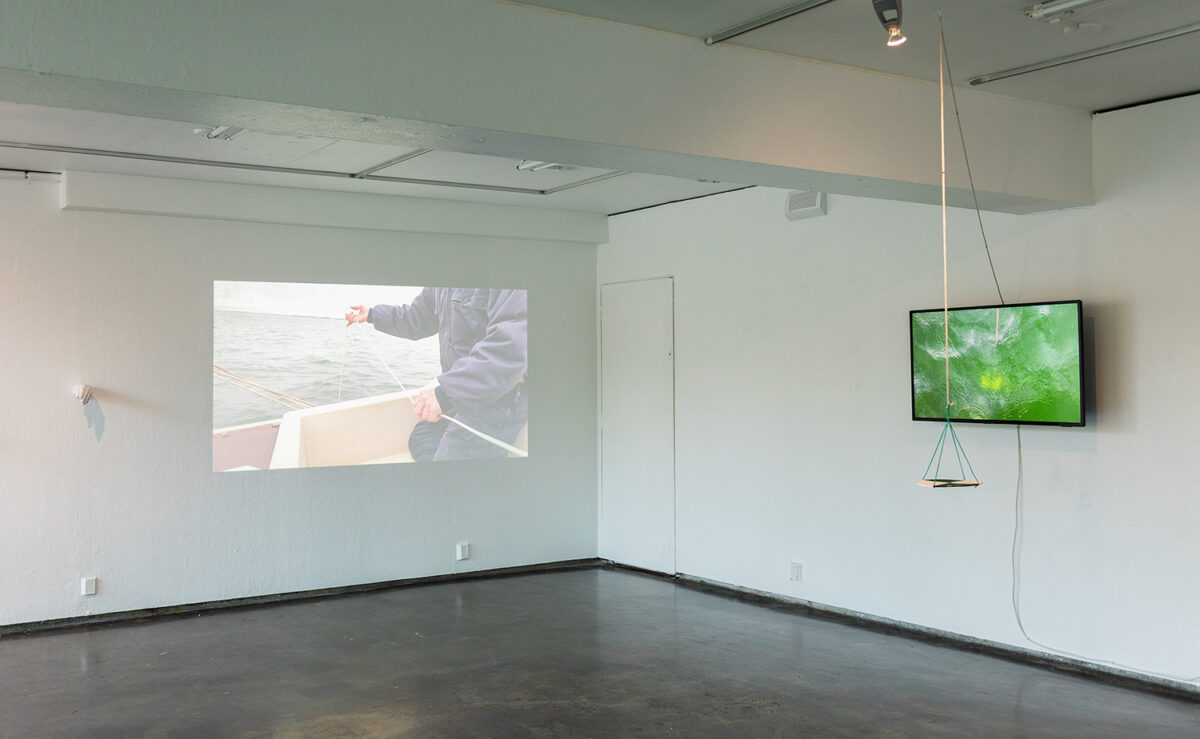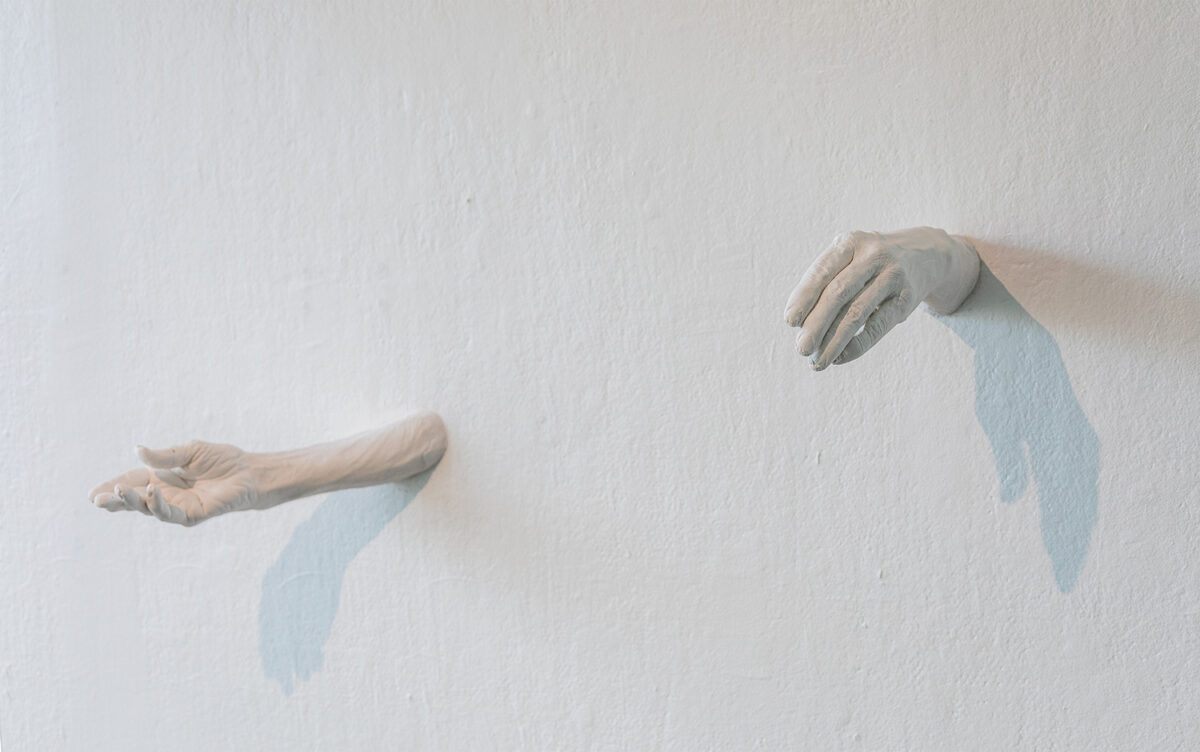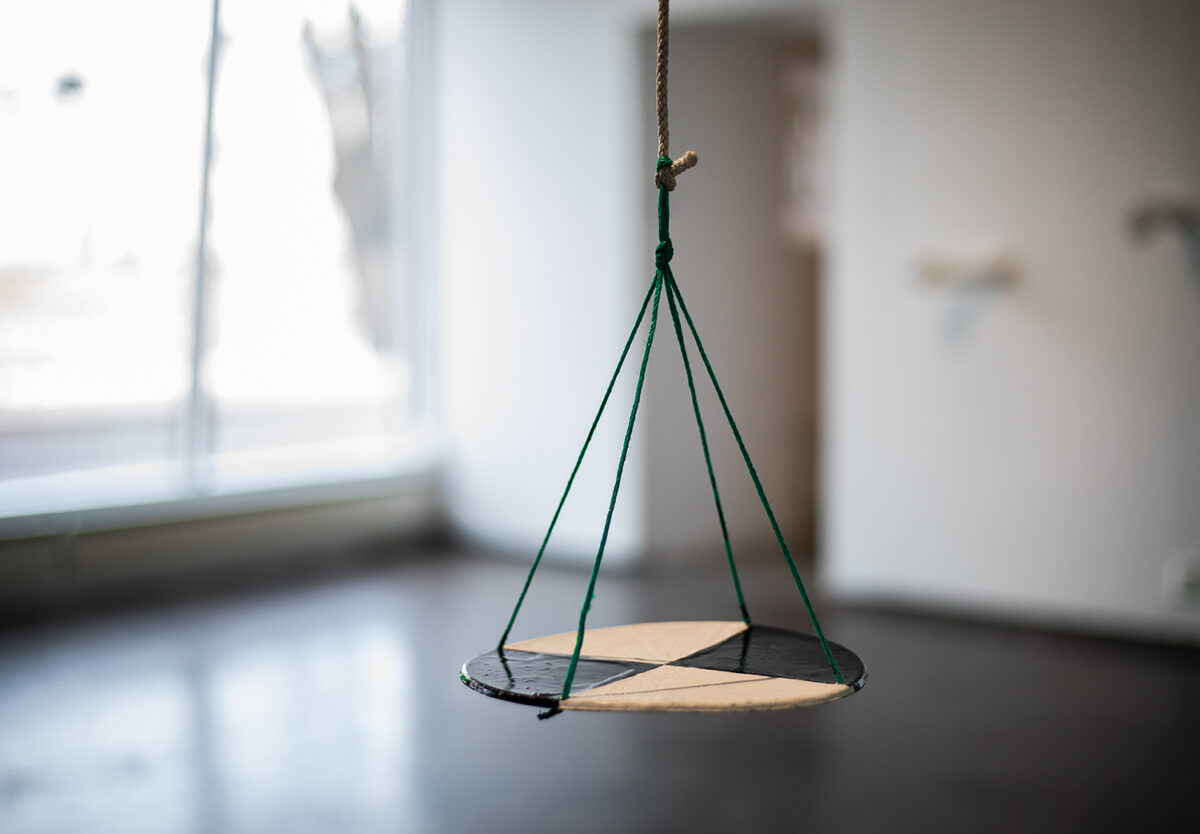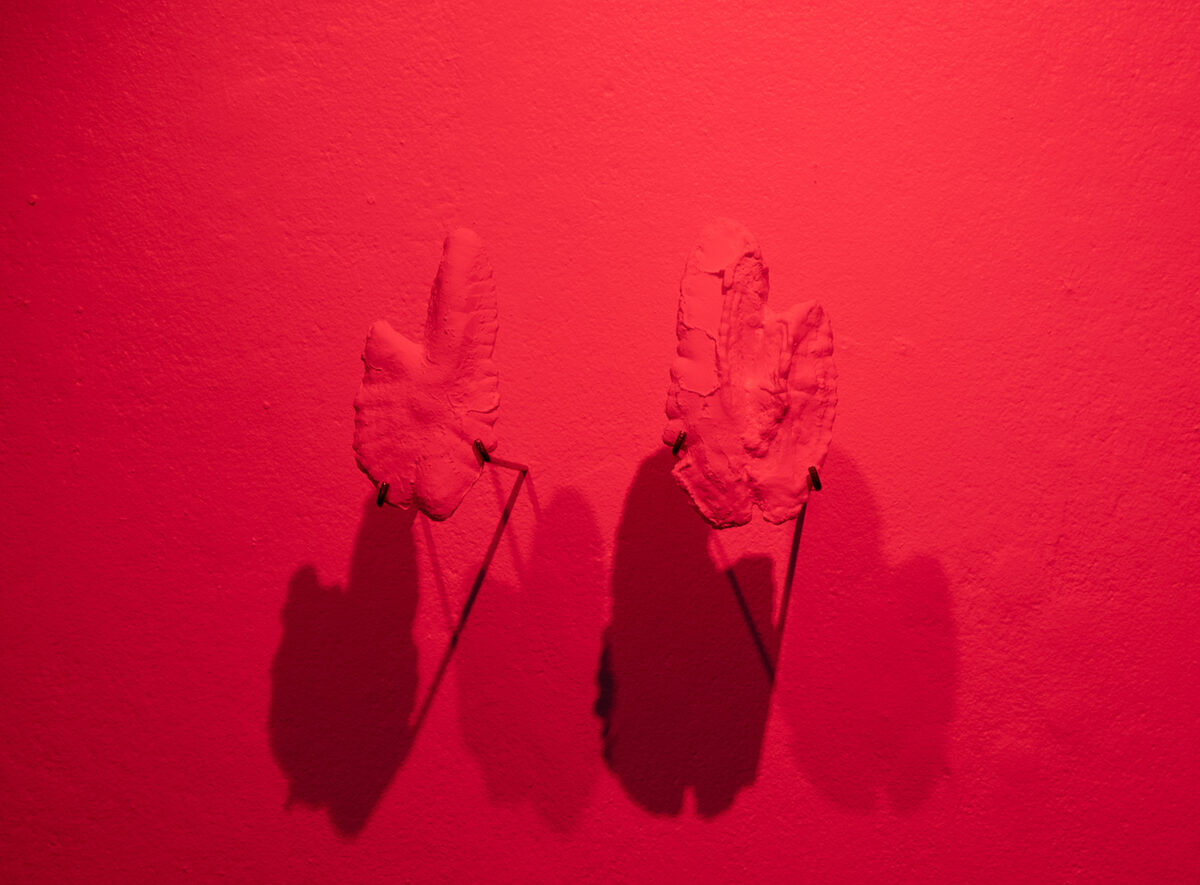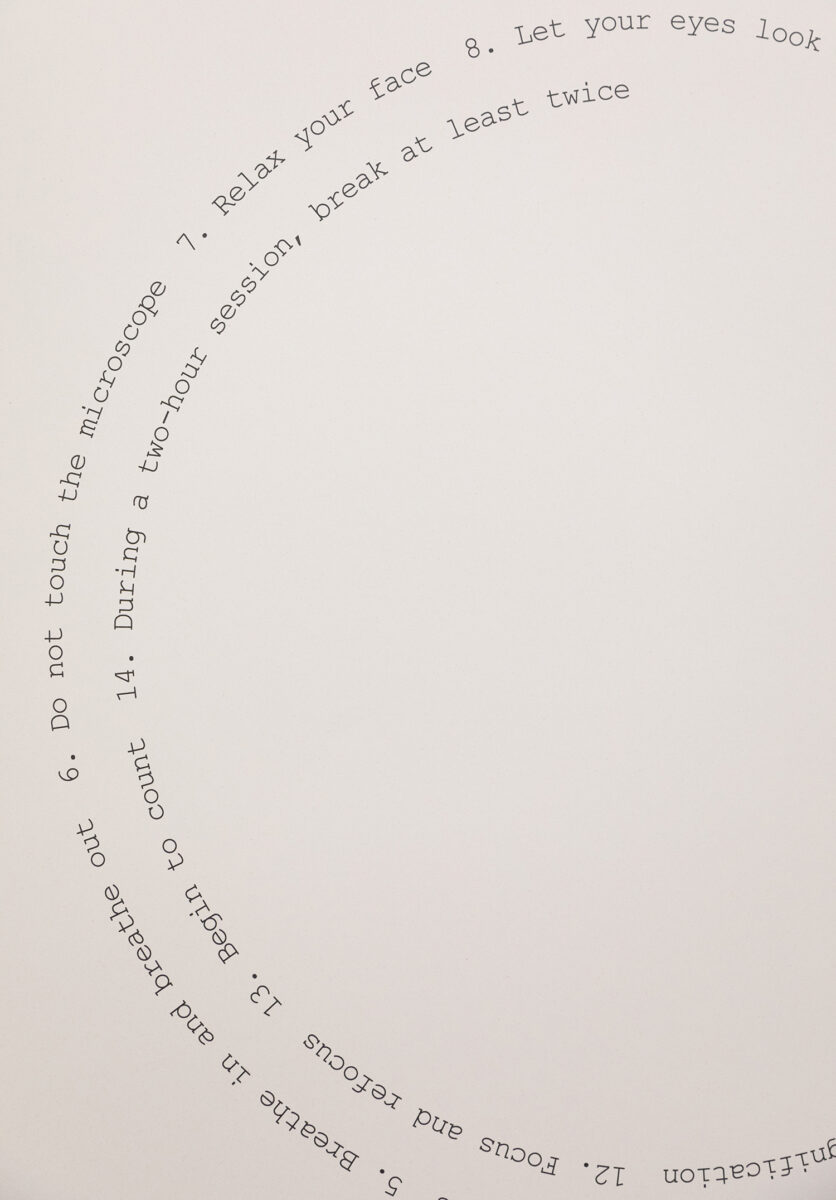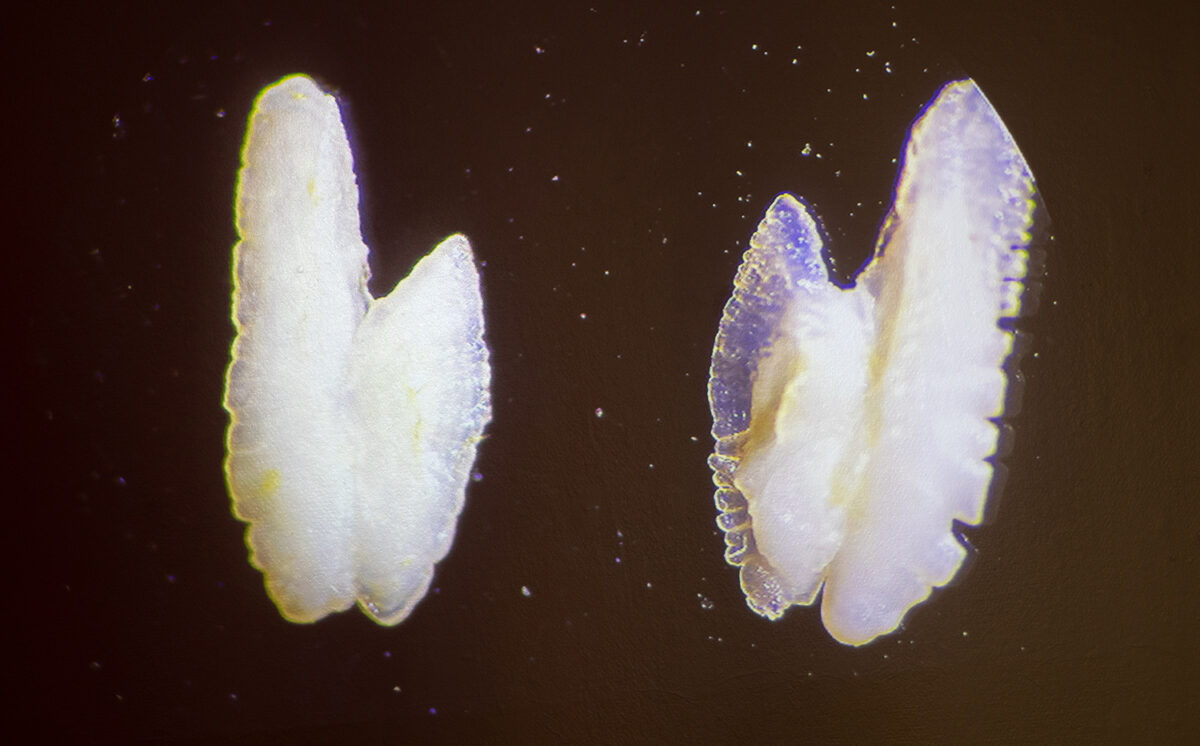Conversation: Matterlugy, Taru Elfving, Jari Hänninen and Katja Mäkinen
3.2.2023
Titanik Gallery, Turku
Matterlurgy (Helena Hunter and Mark Peter Wright) were joined by curator Taru Elfving, professor Jari Hänninen and researcher Katja Mäkinen from the Archipelago Research Institute to discuss the current exhibition Field Casting at Titanik Gallery, Turku, in the context of the marine research that the artists have been engaging with at the institute on Seili since 2019. Throughout this public event, the panel conversed about the importance of site-sensitive fieldwork in which the embodied experiences of scientists, artists and fish alike are crucial to understanding the intergenerational data-sets that evidence the critical environmental changes in the Archipelago Sea. In particular, the discussion and exhibition make visible the socio-ecological traces left in the bodies of scientists and fish – more specifically, professor emeritus Ilppo Vuorinen and the Baltic herring – and propose that we consider the strata of agents (vertebrates, algae, technology) which contribute to the production of knowledge.
CAA shares excerpts from the conversation with Helena Hunter, Mark Peter Wright, Taru Elfving, Jari Hänninen and Katja Mäkinen. The event was held in English.
Taru Elfving: Welcome to the exhibition, Field Casting, which is one of the outcomes of the five-year project, Spectres in Change. The aim of the project is to nurture slowly, and with care, the dialogue between artists and scientists working with questions concerning climate and biodiversity crises and, more specifically, the environmental changes in the Archipelago Sea. It has been an incredible process of collaboration: the Archipelago Research Institute and the staff there – including Jari Hänninen and Katja Mäkinen – have been so generous and open to sharing their knowledge and inviting artists to work with them. Our focus has been on fieldwork – meeting in the field instead of in the classroom or gallery – and on sharing methods across disciplines and asking one another: how do you observe, collect and analyse data; how do we engage with climate change; how is knowledge produced?
The question of how do you know what you know has come up time and again, and it has allowed us to deepen our understanding of each other’s practices but also to understand them together with changes in the ecosystem that we are working with and within. Observation is a key thing that has brought the artists and scientists together, and we have come to realise that there’s a shared commitment to focusing on small details that are otherwise, in our society, beyond our vision, senses and awareness. This has led us to ask: how do we engage with that which hovers at the peripheries of our understanding, and what change in us might this knowledge open up?
Perhaps Helena and Mark would like to begin by talking about their experiences over the last few years?
Mark Peter Wright: The first time we went to Seili was in 2019. We jumped straight into doing method-swaps – as artists, we’re interested in practice and in doing things – and that was a thing that we felt we could converse with in science: how do you do your research and how do we do ours in the field? We undertake a lot of field-based practice as part of our artistic work and we’re interested in being open with sharing things. We did tick collection, where you sweep through the long grasses with a wooden square and net which was incredibly humbling as a tool and a technology. Prior to this, we had ideas of hyper-technological objects but this thing was so elegant, simple and beautiful. Those exchanges were really important to us as it made us realise that a lot of the technologies in science have quite gentle and unassuming properties to them. It felt similar to how we approach practice, where we often put things together in a DIY way.
For us, the initial theme of Spectres of Change overlapped with a question that we often work with as artists: how does data become data? Frankly, we don’t always understand graphs, and so it’s important for us to see how data is produced. There are a lot of practices, methods, tools and approaches involved in data: we started to focus on the modes of knowledge that exist in field work that are outside of the conventional graph or spectrogram. That’s how we ended up focusing on the body, posture, bones and all of these different types of knowledge and witnessing to climate and its changes.
Helena Hunter: Yes, and also different kinds of reading and looking. We wanted to make elements like Ilppo Vuorinen’s arms and the herring’s otoliths very present. Ilppo’s arms are recording devices in themselves: they’ve been involved in this research for so long, casting the line and collecting the plankton which is then analysed and tells scientists of global environmental changes. We wanted to foreground the presence and absence of the scientist’s body within scientific practice as a kind of spectre: the detail and time in Ilppo’s arms can be read in a similar way to how the years of the herring’s otolith can be read. There’s also a human-non-human relationship here between the hands of the scientist and the animal ear.
Mark: We asked Ilppo, what is the position you’ve done the most in your research, and he says “that’s easy: it’s this position [the casting the line stance]. I’ve done this for 30-40 years”. It’s an interesting posture that we felt we wanted to tune up. [It is visible in the exhibition through Field Casting, 2023, a video work and a sculptural replica of Ilppo’s arms cast from an alginate mould].
Helena: With these observations came questions of sense and sensation: what sense and sensation, subjectivity and sensitivity is within science, and how could we tease this out? There’s bits of colour on this rope behind us [gestures to the Secchi disk hanging in the gallery] and they measure different depths of the ocean. Ilppo feeds this through his hands and he can feel the measurements – each notch equates to one metre. There’s something quite poetic in the notion that, as you touch, you’re measuring the depth of the ocean. This tactility, and the physicality and materiality of the research, was something we wanted to hone in on.
Mark: It was interesting for us to think about the very efficient form of data collection that is being performed by this buoy [points to the video Oh Buoy! 2023] – the yellow automated machine hovering on the periphery – and to ask what’s being lost if we take away the field practice and the very embodied tacit knowledge that is accrued over time in a place.
Helena: These videos [Field Casting and Oh Buoy!] work in tandem with each other: while one shows the physical presence of the scientist, the other shows the automation of data collection. There is repetition, but here [in Oh Buoy!] we zoom in on the buoy to emphasise the absence of the scientist’s body. We talked a lot about the importance of the scientist, the person in the field, and the information that is key to understanding the data: the difference between just looking at data and having that field based understanding of where it has come from and the conditions in which it was recorded – I think, Jari, Katja, you call it metadata?
Jari Hänninen: Yes, metadata is where you describe the methods and conditions in which you acquire the data so that someone else could repeat it. If you think about the information gathered in ecological studies, it can easily take two-three years until you have enough data to publish it. It’s important to have consistency in how the samples are gathered.
Katja Mäkinen: It’s essentially data-on-data. Many things like, for example, the weather can affect how accurately the samples reflect the conditions of the sea. The more detail that we have on the data collection process itself, then the better we can understand the data sets. There’s room for error – we’re all human – and different things can happen when taking samples: as a human, you can mistake one species for another, or there is an abundance of one species which leads to misreading the presence of another.
Taru: So when a machine takes samples, is the variance in the way that data is collected quite low?
Jari: This is something to be aware of: it could be reliable or not. For example, if the machine is wrongly calibrated, then the readings will be inaccurate. Even when you have a machine, you are always watching it. You have to go with your hands, take water samples and check it all the time.
Katja: There is always a person monitoring the data collection. If there is an issue with the buoy, you have to go and fix it – you can’t trust the machine.
Taru: We found some old hand-drawn graphs at the station [on display in the exhibition]. With a cultural historian, we began conversing about handwriting compared to computer typing, and how our hand is connected to our brain in complex ways. What happens in that change, in the way that we relate to and process knowledge? In terms of long-term practices and experiences, we have had five years of learning about what you do. It’s really about embodied practices – you’re learning by doing – and the passing on of these methods and knowledge is crucial for the next generation. What are your thoughts on the intergenerational aspect of science?
Jari: It’s an important process: we have learnt something, and then we might retire, but we have to somehow transfer that knowledge to future generations.
Katja: As part of the university, teaching is a key way in which we transfer this to the students.
Taru: It’s not just in teaching but with research – something which is particularly visible through the relationship between docent Marjut Rajasilta, who has been studying at the Institute for 50 years, and Katja. The work doesn’t happen in one scientist’s lifetime; it’s very much a cross-generational knowledge development. And it becomes really clear in the field – it isn’t just about reading and learning but through doing the science as well.
Helena: Something that drew us into the research was the exchange between Marjut and Katja, and their obsession with the herring earbone: the constant counting and working with these fish, and the gathering of different practices like learning how to fish from local fishermen. We were really interested in this dialogue between two women, and everything – shared, sensory, intergenerational – that you found in the process of working with these earbones. Reading the ridges in the otolith like tree-rings reminded us of an occult practice in divination but also brings with it a sadness in that these lines are getting fainter and fainter because of the environmental changes. We sat and asked you many questions about your work – how was that experience for you?
Katja: You take these methods, processes and knowledges for granted and, as a researcher, you get really immersed in the things that you do. Then, someone comes in and it can be difficult to describe the work, but it is usually a really interesting conversation that makes you think about the way you do research. It’s always fruitful, sparks new ideas and brings my attention to things that I may have overlooked. It’s good to have an open mind.
Mark: It is interesting to think about pedagogy in fieldwork and labwork, and the training and learning aspect of it. There’s a sheet of paper hung up in there [indicating towards Sit like you are riding a horse (text score for Ilppo Vuorinen), 2023, in the far room] with a circular print on it. It displays Ilppo’s protocol of how to look through a microscope. It has never been written down; it is just something that he does. It was interesting to tease this out with Ilppo and to think about the tacit protocol for doing something that is second nature to him. It goes back to how things are done: how is that data produced; what type of looking is going on; what type of embodied knowledge is used to engage with something? We, too, take for granted what we do, and it’s sometimes awkward when someone asks us about it.
Jari: This is a good point. There is a lot silent information in analysis. In a research paper, you often write, “I used microscope”. But it’s only one phrase. Ilppo taught Katja and myself to observe the entire area exposed under the microscope. There’s a certain way of doing things, and it’s not just about conventional ways of looking.
Taru: It’s very much about connecting looking and knowing to a multi-sensory embodied process. Looking is never abstract but it’s a very physical practice in itself. The method is ‘the microscope’ but there are so many other things present in the method like posture, reading etc. These complex, embodied processes have come through in our discussions, and when artists have been asking the scientists “but how do you do that, how do you see that there?”
Audience: Katja, could you describe the herring otolith bone in a little detail?
Katja: The otolith bone is a calcified structure in the head of the fish and it is commonly used by scientists to determine the age of the fish. You can use scales to determine age also. It is standard practice to use the otolith to identify factors about the fish. I like to use the analogy of a ‘black box’ as the otolith records various details throughout the fish’s lifetime: age, growth rate, elemental information – with these you can, for example, record the herring’s migratory patterns from the Archipelago Sea to the Bothnian Sea. Otoliths are like natural tags.
Jari: You can understand a herring’s life history through its bones.
Helena: We were thinking a lot about artist and researcher Susan Schuppli who talks about the ‘material witness’. In a way, this bone is a material witness to climate and environmental change. The print on the gallery window, Otolithic Evidence, explores the idea of how witnessing and gathering evidence from more-than-human perspectives becomes really crucial to understanding human impacts on the environment.
Taru: In case anyone isn’t familiar with the herring research, what are the key things that the herring has told us?
Katja: The project was initiated in the mid-1980s with the aim of studying the reproductive biology of the herring in the archipelago area. Questions such as where does the herring reproduce, how often, and which environmental variables affect it are central to this work. The herring comes to reproduce in the Archipelago Sea every spring and we monitor the traits of the spawning fish: their size, weight, maturity, age and fat content, for example. This herring survey, together with other environmental monitoring datasets, has been crucial to understanding how the sea has changed in the recent decades.
Jari: One of the reasons that we started the study in the 1980s was to monitor some of the ecological changes in the Baltic Sea. The herring is part of a short food chain: it is a fish that eats zooplankton and so, through observing changes in the herring, we can observe changes in the zooplankton community.
Taru: What has happened to the herring in the last few decades?
Katja: Many things have changed, but perhaps one of the most notable shifts is the diminished size of the fish. With regard to reproduction, we have seen, for example, that the quantity and quality of the herring’s lipids has changed. Recently, we have studied alterations in its thyroid hormones which tells us that the herring is adapting to the shifts happening in its environment. The physiology of the fish is changing – and that has an affect on its reproductive capacities. In recent years, we’ve also been studying how the increase in temperature and decrease in salinity affects the embryonic development and the quality of the offspring.
It’s important to note that there are spatial and temporal changes in the Baltic Sea – and students, in particular, need to understand that the Baltic Sea is not the same in every area, and that it changes with time also. With herring, as it varies so much, it’s important that we have these long time series. If we had looked at just the first 10-15 years of the time series then we would have a very different picture to when we look at the whole time series of 40 years.
Helena: It’s so forensic – and the forensics of environmental change really stuck with us. It made us think about Rob Nixon’s term ‘slow violence’ and how a version of this ‘slow violence’ is visible in the fish’s body. It is really fascinating to us, this forensic way of looking at these changes, and that there’s evidence of these changes in the fish.
Katja: It’s like building a puzzle, piece by piece. Slowly, you get a bigger picture, but there are still so many questions that we don’t have answers to.
Taru: I’d like to go back to plankton. Plankton are so fundamental to the food chain and to life itself as they produce around half of the planet’s oxygen. What has happened to the plankton community in recent decades, and what does the time series of 40-60 years of data reveal?
Jari: Due to climate change, the rainfall in the Baltic Sea catchment area has increased a lot since the middle of the 1980s. Because of this, the seawater salinity has decreased significantly and the Baltic Sea zooplankton (which come from the Atlantic Ocean) are replaced by freshwater zooplankton – a type of plankton which thrive in these low salinity conditions. This is bad news for the herring because they eat marine zooplankton, which are much bigger in size. The shift in zooplankton communities disrupts the food chain and it is one reason why the herring’s size has decreased by 60% since the 1980s.
Helena: In thinking about plankton, and also the Secchi disk, we became very interested in the idea of the sea’s surface layer being full of life: it’s where a lot of the zooplankton and phytoplankton live and their presence or absence affects the visibility of the sea. In the exhibition, we’ve referenced the plankton through the casting of Ilppo’s hands out of alginate (made from a brown seaweed) and the use of Alga Carta paper (produced from algal blooms in Venice) to print Ilppo’s score.
Audience: What do, Jari and Katja, think about the exhibition? How have you, the scientists, received this artistic translation of your research?
Katja: I think it is very fruitful, this collaboration between the artists and ourselves. It is important for us to tell the public about our research, but we, as scientists, are not well equipped to share the research in a meaningful way to a wide public. The scientific process normally ends up in a peer reviewed publication and that’s usually it. There aren’t the resources to attract larger publics. In collaborating with artists, we can get our message across in a meaningful and interesting way, and the artists get their own positive aspects from our side as well.
Jari: I personally find it very fruitful. Scientists are quite dull people: there are such strict rules for writing and reporting the results of research. Artists question and examine what we are doing and why we are doing it. This can also change our scientific systems and ways of expressing ourselves.
Taru: From a personal perspective, people seem to have a lot of fun together in the field. Today, we are sitting here, rather stiff, but when meeting out in the field and doing work that is meaningful in many ways to all of us, we’re constantly learning from each other and finding new, exciting things. I strongly believe that’s why this multidisciplinary work needs to take place out in the field rather than in the seminar rooms. So much more happens when you meet there: the place itself becomes part of the conversation.
Matterlurgy, Field Casting, at Titanik Gallery, Turku, runs until Sunday 5 March 2023.
Field Casting is part of the programme How do you know what you know? Exercises in Attentiveness which presents new artworks commissioned by CAA in collaboration with the Archipelago Research Institute (University of Turku) in the project Spectres in Change.
The exhibition and the events are produced by CAA in partnership with Titanik Gallery and the Archipelago Research Institute (University of Turku). With support from the Kone Foundation, Swedish Cultural Foundation in Finland and Oskar Öflund Foundation. Thanks to Eero Merimaa and sculpture students at Turku University of Applied Sciences, Tom Ranson, and Alex Ball at the Natural History Museum in London, UK.

